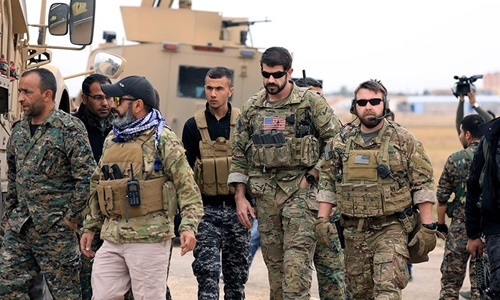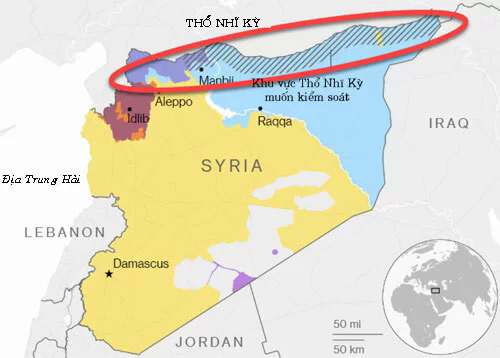Retreating in a hurry, American soldiers are easily exposed to risks such as unexpected clashes or IS attacks.
President Donald Trump's decision, made within a week, to withdraw 1,000 U.S. troops from northern Syria is keeping the Pentagon and forces on the field unable to keep up, experts said. To carry out "endless wars" abroad from 2001 to the present, as Trump sums it up, the US military has perfected the ability to build complex logistics systems that can take everything from armored cars to satellite Internet or gym equipment directly to outposts across the Middle East.

US troops and members of the Kurdish Syrian Democratic Forces (SDF) patrol near the Turkish border Photo: Reuters
Now US troops are making a hasty retreat from Syria under pressure from Turkish proxies, Russian fighters and armored vehicles from Syrian authorities. This meant that the Pentagon had to dismantle combat bases and other infrastructure that had been built to serve a mission that would have lasted, while protecting the lives of soldiers in their process. retreating from a chaotic battlefield.
Before Turkey launched its military operation on 9 October, US troops, mainly from special forces, were stationed at more than 10 bases and outposts throughout northeastern Syria, alongside their allies. Kurd. They are divided into two main offices, Eastern Headquarters and Western Headquarters.
The outposts are a collection of tents resistant to all kinds of weather, relatively rudimentary buildings and explosion-proof walls called Hesco fences. The air base in Kobani is like a miniature city full of camping tents and container houses.
The western headquarters monitors nearly 10 smaller outposts, covering cities like Manbij and Raqqa, gathering about 500 soldiers.
The eastern headquarters is closer to the Iraqi border, operating nearly 500 soldiers in the area around the Euphrates river valley, with a few small outposts around the city of Deir al-Zour and towns near the Syrian-Iraq border such as Bukamal Or Hajin. The number of troops in the east is constantly fluctuating because they are constantly moving between Syria and Iraq.
When the US military withdraws, they will first retreat inside by abandoning outposts close to the enemy's advance, in this case the Turkish army and proxy forces. Ankara-backed in Syria, with Russian and Syrian government troops. The strategy was evident in a video posted on October 15 that showed a Russian reporter standing in the middle of an abandoned U.S. outpost west of Manbij, close to the location of the Syrian government army.
Colonel Myles B. Caggins III, spokesman for the US-led military alliance based in Baghdad, confirmed the same day on Twitter: "We have left Manbij".
Soldiers are expected to redeploy forces in Iraq or Jordan. Some may return to America.
The east and west headquarters are expected to withdraw independently. In the west, the US military is likely to leave by Kobani airport, the so-called Kobani Landing Area. This base can accommodate C-17 transport aircraft and a large maintenance staff. In the east, soldiers are expected to retreat by road, into Iraq in long convoys, others traveling by helicopter.

Turkey's safety buffer zone wants to establish on the border with Syria Photo: HAL.
According to experts, in the process of withdrawing, the risk of US soldiers clashing with other ground forces will certainly be higher than a few weeks ago.
The movement of convoys through disputed territories and planes taking off many times is potentially dangerous, leading to an accidental confrontation or even the US military could be attacked suddenly, especially In particular, from the remaining Islamic State fighters (IS), the force is seeking to rise again in Syria.
One of the biggest risks that US troops remain in Syria during a gradual retreat is that they are attacked by the Free Syrian Army (FSA), a Turkish-backed militia. The FSA has led many Turkish attacks along the border.
US officials say these Turkish-backed militias are often not as disciplined as Turkish Orthodox soldiers and have accidentally or deliberately shot at US troops while they are withdrawing.
The hasty, risky nature of the withdrawal may require the United States to increase the number of US troops in Syria, at least temporarily. The US Central Command is preparing to send hundreds more troops to help protect the US special forces bases with the Kurdish militia partners in Syria and support the evacuation process in the coming weeks. .
"We are redeploying additional forces in the region to support force protection as needed," US Defense Secretary Mark T. Esper said last week at the Pentagon.
It is not clear how US combat equipment in Syria will be handled. Some bases with fixed structures, tents, fitness equipment or large construction machinery may be left behind. What the US military is sure to carry is sensitive items, equipment such as radios, weapons, armored vehicles and important documents.
US Army officials said "the faster the withdrawal, the more equipment they have to leave or destroy," largely depending on security conditions on the ground.
Turkey's safety buffer zone wants to establish on the border with Syria. Graphics: HAL.



 FrancisSoh
FrancisSoh







